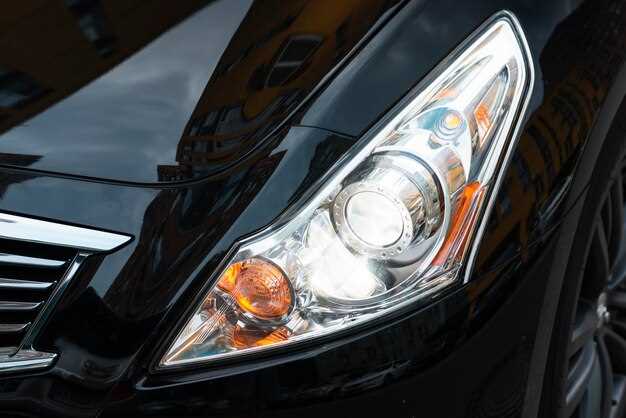
Flickering headlights can be more than just an annoyance; they can indicate underlying issues with your vehicle’s electrical system or components. When headlights fail to shine consistently, it raises concerns about visibility and safety on the road. Understanding the reasons behind this phenomenon is essential for both preventing potential hazards and maintaining your vehicle’s performance.
There are several common causes of flickering headlights, ranging from simple bulb malfunctions to complex electrical problems. Weak connections in the wiring, worn-out headlight bulbs, and faulty alternators are frequent culprits. Each of these issues can lead to an inconsistent power supply, which presents itself as a flickering effect that can distract or confuse other drivers.
Additionally, environmental factors such as corrosion or moisture can exacerbate these problems. Identifying the specific cause of flickering headlights is crucial for timely repairs. By addressing the root of the issue, you can enhance your driving experience and ensure a safer journey on the road.
Identifying Electrical Issues That Cause Flickering
Flickering headlights can often be traced back to specific electrical issues within a vehicle’s system. Understanding these problems is essential for timely diagnosis and repair. One common cause is a weak battery. As a battery ages, it may struggle to provide consistent power, particularly under the strain of additional electrical components.
Another potential issue involves the alternator. The alternator is responsible for charging the battery while the engine is running; if it malfunction or begins to fail, it might not supply steady voltage, resulting in flickering lights. Regularly checking the voltage output of the alternator can help identify this problem early.
Worn or corroded wiring can also contribute to flickering headlights. Corrosion at the connectors can impede the flow of electricity, leading to inconsistent power delivery. Inspecting wires for damage, fraying, or corrosion is crucial for maintaining electrical integrity.
Faulty headlight bulbs may seem like an obvious culprit, but they can also create flickering as they reach the end of their lifespan. A bulb that is loose in its socket can further exacerbate this issue by creating intermittent connections.
Lastly, issues with the vehicle’s ground connection can lead to electrical instability. A poor ground can cause fluctuations in power, manifesting as flickering headlights. Ensuring that ground connections are clean and secure is vital in preventing this problem.
How Worn-out Bulbs Impact Headlight Performance
Worn-out bulbs are one of the most common factors affecting headlight performance. As bulbs age, their filament deteriorates, resulting in decreased brightness and inconsistent illumination. This gradual decline can lead to inadequate lighting, which is particularly dangerous during night driving or adverse weather conditions.
When a bulb is nearing the end of its life, it may flicker intermittently. This occurs due to a weak filament that struggles to maintain a steady current. The flickering not only distracts other drivers but also signals an underlying issue that needs attention. If one bulb starts flickering, it’s often advisable to replace both bulbs, as they typically have similar lifespans.
Additionally, worn-out bulbs can affect the alignment of light output. A bulb that is failing may not produce light at the correct angle, leading to poor visibility on the road. This misalignment can result in blinding oncoming traffic or insufficient lighting for the vehicle’s path, increasing the risk of accidents.
Temperature fluctuations further compound the issues associated with worn-out bulbs. An aging bulb can be more sensitive to temperature changes, causing it to flicker or dim when exposed to cold weather or when the vehicle’s electrical system experiences fluctuations.
In summary, worn-out bulbs significantly impact headlight performance by reducing brightness, causing flickering, misaligning the light output, and being susceptible to temperature changes. Regular inspections and timely replacements of headlight bulbs are essential for ensuring safe driving conditions.
The Role of Battery and Alternator in Headlight Functionality
The battery and alternator are crucial components in any vehicle’s electrical system, directly influencing headlight performance. Understanding their roles can clarify why flickering headlights often occur.
The battery serves as the primary power source, storing electrical energy required to start the engine and operate accessories, including headlights. When the engine is off, the battery provides the necessary voltage to illuminate the headlights. However, as the battery ages or becomes depleted, it may struggle to maintain a consistent voltage output, leading to flickering lights.
On the other hand, the alternator takes over once the engine is running, converting mechanical energy into electrical energy to recharge the battery and power the vehicle’s electrical systems. If the alternator is malfunctioning, it may not produce enough current, resulting in inadequate voltage to power the headlights consistently. Common issues include worn-out diodes, loose connections, or belt problems, which can significantly impact headlight brightness and stability.
Moreover, fluctuations in electrical demand from other systems in the vehicle can also affect headlight performance. For example, the simultaneous operation of air conditioning or power windows can draw power away from the headlights, causing them to dim or flicker intermittently.
In summary, both the battery and alternator play vital roles in ensuring that headlights function properly. Regular maintenance and timely replacement of these components can prevent flickering problems and enhance overall vehicle safety.
Examining Wiring Problems and Their Effects on Headlights

Wiring issues are one of the most common culprits behind flickering headlights. Over time, the electrical connections that power the headlights can degrade or become damaged, leading to inconsistent power supply. This may be due to corrosion, wear, or physical damage to the wires. When wiring is compromised, it causes intermittent contact, resulting in headlights that flicker or dim.
Corroded terminals and connectors can disrupt the flow of electricity. As moisture and dirt accumulate, oxidation occurs, which increases resistance in the circuit. This heightened resistance can lead to fluctuations in voltage, making headlights behave erratically. Regular inspections of wiring and connectors can help identify such issues before they escalate.
Wire fraying is another potential issue. When wires are exposed to wear and tear, especially in areas subjected to movement or mechanical pressure, they can start to fray or break. This can create a short circuit, causing the headlights to cycle on and off unexpectedly. In severe cases, it can lead to a complete failure of the headlight system.
Additionally, loose connections can play a significant role. If the connections between the wire harness and the headlight assembly are not secured properly, it may result in flickering lights. Vibrations from driving can exacerbate this problem, loosening connections over time. Ensuring all wiring connections are tight and secure can prevent this issue.
Finally, the age of the vehicle can also affect the condition of the wiring. Older vehicles may have wiring that has deteriorated due to heat exposure, environmental factors, or general wear. It is important to regularly maintain and replace aging wiring to ensure optimal headlight performance and safety on the road.
Understanding Adjustments Needed for Headlight Aim
Proper headlight aim is crucial for safe nighttime driving, as misaligned headlights can lead to reduced visibility for the driver and increased glare for oncoming traffic. Regular adjustments are necessary to ensure that headlights illuminate the road effectively without causing distractions to other drivers.
The first step in adjusting headlight aim is to determine if the headlights are properly aligned. This can be tested by parking the vehicle on a flat surface facing a flat wall about 10 to 25 feet away. The headlights should be turned on, and the light beams should be visually marked on the wall. Typically, the center of the beam should be slightly below the height of the headlight. If they are not aligned correctly, adjustments should be made.
To adjust the headlight aim, locate the adjustment screws, which are usually found on the headlight assembly. Most headlights have two screws: one for vertical adjustment and another for horizontal adjustment. The use of a Phillips screwdriver or a flathead screwdriver, depending on the screw type, is required for this task. Adjust the vertical screw to raise or lower the beam and the horizontal screw to shift the beam left or right.
After making the necessary adjustments, it is important to re-test the aim using the same flat surface method. Check the alignment again to ensure that the adjustments provided the desired result. Properly aimed headlights not only enhance visibility but also contribute to safe driving by reducing the risk of blinding other drivers.
Regular maintenance of headlight aim is recommended, particularly after any front-end repairs, changes in vehicle height, or if the vehicle has had significant wear and tear. By keeping headlights properly aimed, drivers can improve their safety as well as that of others on the road.
Knowing When to Seek Professional Help for Headlight Flickering
Understanding when to seek professional assistance for flickering headlights is crucial for both safety and vehicle maintenance. Flickering can indicate a variety of underlying issues that could lead to more significant problems if not addressed promptly. Here are some key indicators that suggest it’s time to consult a professional mechanic:
- Persistent Flickering: If the flickering persists despite checking the bulb connections and replacing any burned-out bulbs, it is essential to seek professional help. Continuous flickering may suggest an underlying electrical issue.
- Fluctuations with Engine Performance: Noticeable changes in headlight brightness in correlation with engine performance can indicate alternator issues. If the headlights dim when accelerating or flicker during idling, a mechanic should evaluate your vehicle’s electrical system.
- Burned or Discolored Sockets: If you observe signs of overheating, such as burned or melted sockets, this warrants immediate professional inspection. Such damage can lead to further electrical problems or fire hazards if not addressed.
- Frequent Bulb Burnout: Regularly replacing headlights can be a sign of an electrical problem, such as incorrect voltage supply. Consulting a professional can help diagnose the root cause and prevent future issues.
- Dashboard Warning Lights: If the flickering is accompanied by dashboard warning lights, particularly those related to the battery or electrical system, it is crucial to get your vehicle checked by a professional.
- Unusual Sounds or Smells: If there are any accompanying unusual sounds, such as popping or sizzling noises, or if you detect burnt odors, these could suggest serious electrical problems. Professional evaluation is necessary in such cases.
Ignoring the flickering of headlights can lead to dangerous driving conditions and expensive repairs. If you experience any of the above indicators, it is wise to consult with a qualified mechanic to ensure your vehicle remains safe and reliable.














